Stepping down from Monty, my camper van, parked on the edge of the woodland where we are going foraging for fungi, the post-rain smell, the petricor, hits me immediately. That wonderful earthy fragrance lifts more than just the olfactory system. There are reasons why a walk in the woods after the rain is good for the spirits and the soul, and you need look no further than the main component of this petricor, geosmin. It’s made by bacteria released into the air when rain water hits the ground. Studies have shown that breathing it in causes a release of mood-enhancing serotonin, along with many other benefits. The ionised air after rain is also thought to have beneficial effects.
An expert eye
Waiting for me is Kevan Palmer, a bushcraft expert. Kev has learned his craft over many years. Even from a very young age he was always interested in the outdoor environment. In his youth he was a member of both the Scouts and the Woodcraft Folk. As fate would have it, a change of schedule put them on the same night so he had to choose between them. He plumped for the latter. They introduced him to some of the wild things you could eat or make tea from, along with other skills like bird spotting and animal tracking. This sparked his interest in bushcraft and foraging.


Finding fungi in the autumn woodlands requires a keen eye
Over the years, Kev has honed his self-taught skills and now teaches them through workshops. He’s also an expert on making meals from foraged goodies, cooked over a campfire of course, but more about that later. As my guide and teacher today, it’s comforting to know that he has never poisoned himself through foraging, although he stresses it’s so important to be careful with both plants and fungi as some toxic and edible species look alike. Sometimes they even come from the same family.
Fungi and their relationship with trees
As we venture into the woods, Kev explains that the mix of trees is an important part of determining what we’ll find. Many mushrooms, many fungi are associated with particular tree species, they are mycorrhizal. These fungi connect with tree root system and become part of a fascinating symbiotic underground relationship. This association can be quite specific with some fungi only found with particular trees, or even just one tree species.
In this part of the world – we’re in the UK – the key tree species for finding fungi are beech, birch, oak and Scots pine. At the right time of year – autumn after the first cold days or frosts in particular – a woodland with a good mix of these tree species is a great starting point on a fungi hunt. Woodlands of sycamore, ash, maple, willow or lime trees don’t produce many fungi and certainly not the mycorrhizal species.
The woodland we’re in today is mostly birch, with some oak, beech and Scots pine. Autumn is late this year and the weather has been mild, but in the last few days its beginning to change with temperatures dropping and even the first frosts, making this a perfect time.
Plants, fungi and identification
There are three loose types of fungi which we’re likely to find and identification is crucial if you are foraging for the dinner table. What we find will either be edible, mildly toxic and/or unpleasant tasting or poisonous. As a kid I was told that the colour of the gills is the differentiator but, as I quickly found out, you are unlikely to live long with such a simplistic approach and a visit to A&E is most probably the best you can hope for!


Edible plants – Chickweed and Sheep Sorrel
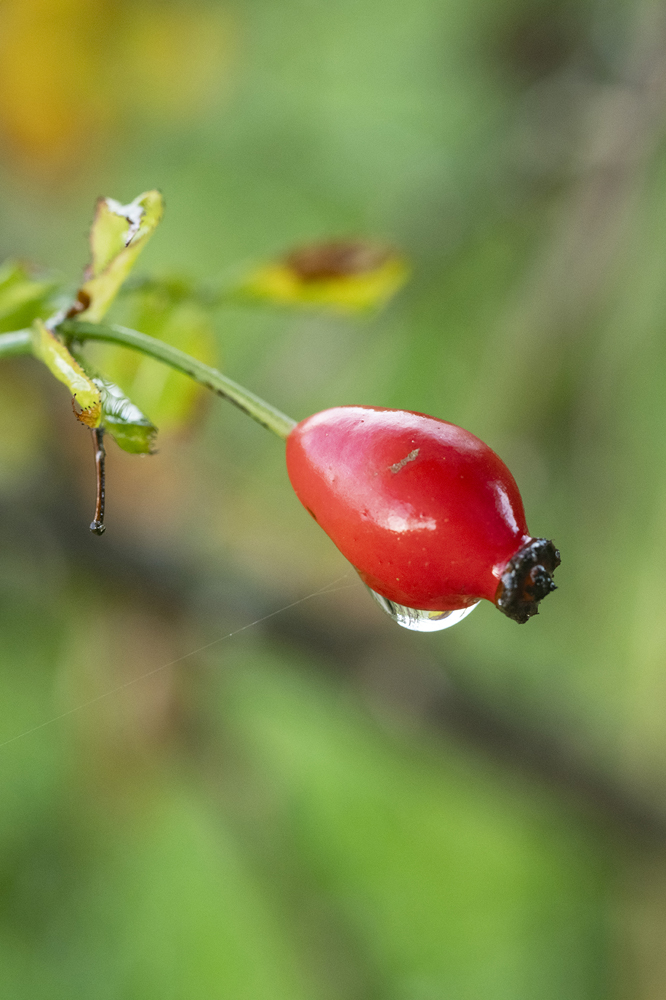
Although early November is not the best time for edible plants, we’ll also be looking for a few along the way. However, retracing our steps next Spring as new growth returns to the woodlands will be much more productive. On the fringes of the woods we immediately find three though – Chickweed, Hedge Garlic and Sheep Sorrel. The chickweed has a similar flavour to pea shoots and can be used as an alternative in salads, but this is one to be careful of. It looks very similar to two poisonous plants – Scarlet Pimpernel and Petty Spurge. Hedge garlic, peppery with a mild garlic taste, bears a similarity to ground ivy. Fruits are few and far between – Blackberries and Hawthorn are over now, or attest past their best – but one which adds some colour at this time of year is the Rosehip (left).
As we head into the woods it takes no more than 20 steps to start this journey of discovery. Near a large silver birch tree we find a ring of Tawny Funnel fungi. Although edible, the flesh is thin and doesn’t have much flavour. They can also be confused with other members of the Funnel family which are poisonous. This fungus is not mycorrhizal. It’s saprobic, feeding on dead and decaying matter on the woodland floor and in the soil rather than having a connection with tree roots. With many saprobic species, the mycelia radiate out in a circular pattern. As they consume the nutrients on the ground they then move the circle outwards.


Tawny Funnel – how the cap joins the stalk is an important part of the identification process
This ring was about three metres in diameter, with part of it hidden amongst the ferns. It develops and spreads through it’s root network and the spores are thrown out concentrically away from the centre of the circle in search of nutrients. A path runs through the particular ring. Kev is not surprised and explains that you don’t need to venture far off woodland paths to find fungi at this time of year. We’re just as likely to find them around the path edges as deep into the more dense vegetation.


A field guide or the Picture Mushroom app is handy for checking identification but caution is still needed
It’s worth saying a word or two about identifying different fungi. Most importantly, if you aren’t sure about any fungi or mushrooms, just don’t risk eating them. I was privileged to be with an expert but even he sometimes uses an app as a guide to be check when identifying one of the more generic looking one. The app he uses is Picture Mushroom, but there are others, but all are reliant on having phone signal. There are lots of really good reference books and field guilds as well, so it’s worth keeping one in your pocket.
Searching the woodland floor




Deceivers, a common species on the woodland floor
Common on the woodland floor are Deceivers. This is a family of fungi which have many different variants and looks, so can look like many other small woodland fungi. They are edible. As Kev and I chatted we came across another edible fungus family, and one which surprised me – Puffballs. I’d always assumed that they were toxic or, at the very least inedible, but that’s not the case. All this family are edible, though taste-wise you’d only really want to eat the younger ones. The Puffball gets its name from the way it releases spores, millions of them at a time, in a puff from a hole at the top of the ball. When the fruit is ripe, the spores are puffed out in response to rain drops or anything else which touches it. As with so many edible fungi, though, it has a toxic cousin – the Earth Ball. The outside looks very similar to a puffball but inside the centre has a black colouration. Other fungi, such Amanita, can look like Puffballs when they are young.







Puffball ejecting spores, young Puffball when most edible, Dusky Puffball, old Puffballs after shedding spores, Earth Ball with black interior
Beware of beauty
Red for danger! It will come as no surprise that many of the bright red coloured fungi are toxic. Although stunningly beautiful and a photographer’s delight, they are definitely not to be eaten. The most frequently seen is probably the Fly Agaric but other common ones are some in the Red Russula family known as the Sickeners. It’s worth noting, though, that even the most toxic fungi isn’t toxic to the touch. You have to ingest it.







A photographer’s dream but not to be eaten – red fungi like Fly Agaric, Sickeners and Russula sylvestris
With all fungi, whether edible and poisonous, similar looking ones can be easily confused. There’s a way to check, but only with Russala or Brittlegill family. You should never do this with other species, Kev explains. If you did this with a fungus like a Death Cap you would be in serious trouble. He picks a mushroom from the Brittlegill family and breaks off a tiny piece, placing it on his tongue. “If it starts to tingle or burn, then it’s poisonous and not one for the pan.”







The edible Glistening Inkcaps (top left); Deer Shields – mildly poisonous with unpleasant taste (top right); Buttercaps and milkcaps, some edible, some poisonous; toxic Brown Rollrim (bottom left) and Sulphur Tuft (bottom right)
Not all toxic fungi are red though. We came across a myriad of different shapes and colours, all of which will make you very ill indeed, or worse. Sulphur Tufts are delicate and look rather beautiful – milky grey/yellow colour – but they are poisonous. The Deer Shield is also another attractive slender one – again poisonous. The Rollrim family are mostly toxic, as are Milkcaps, Bonnets, Pink Gill some but not all Waxcaps and Rust Gill are poisonous. All have exceptions though – Brittlegills are edible, as are Saffron Milkcaps. Incidentally the Milkcaps get their name because if you turn them upside down and brush their gills they produce a milky liquid – usually white or cream in colour. When you do this with a Saffron Milkcap, the milk is orange coloured, as the name would suggest.
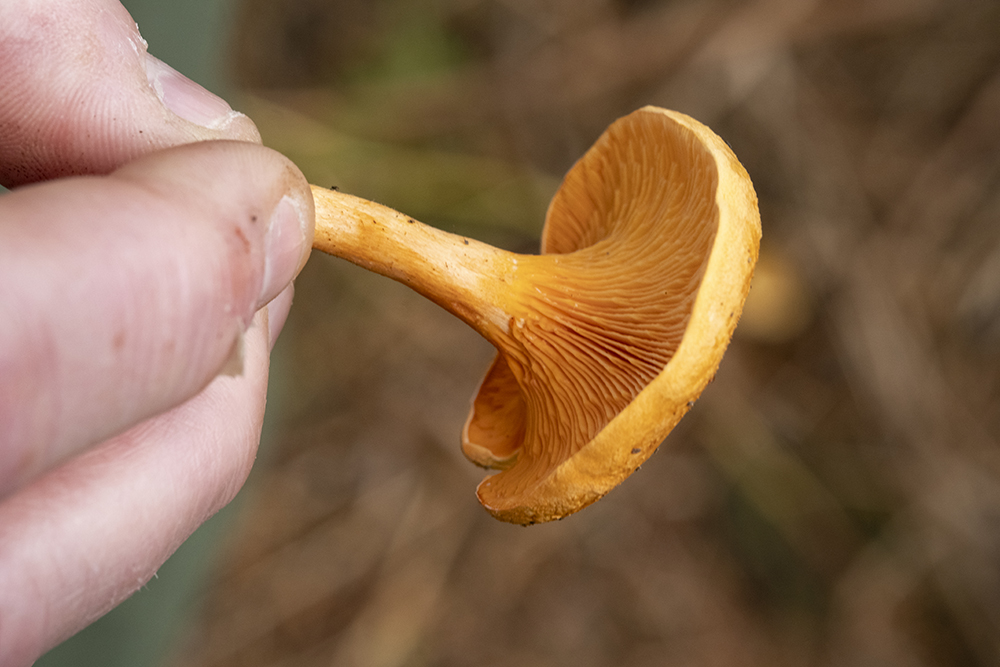
Chanterelle mushrooms are prized by many a cook and chef. You are lucky if you find them but again a note of caution. Looking very similar is the False Chanterelle (right). They are quite a delicate looking mushroom with orange gills underneath. They aren’t deadly but are mildly poisonous so you’d want to make sure you have the right ones before you throw a dinner party!
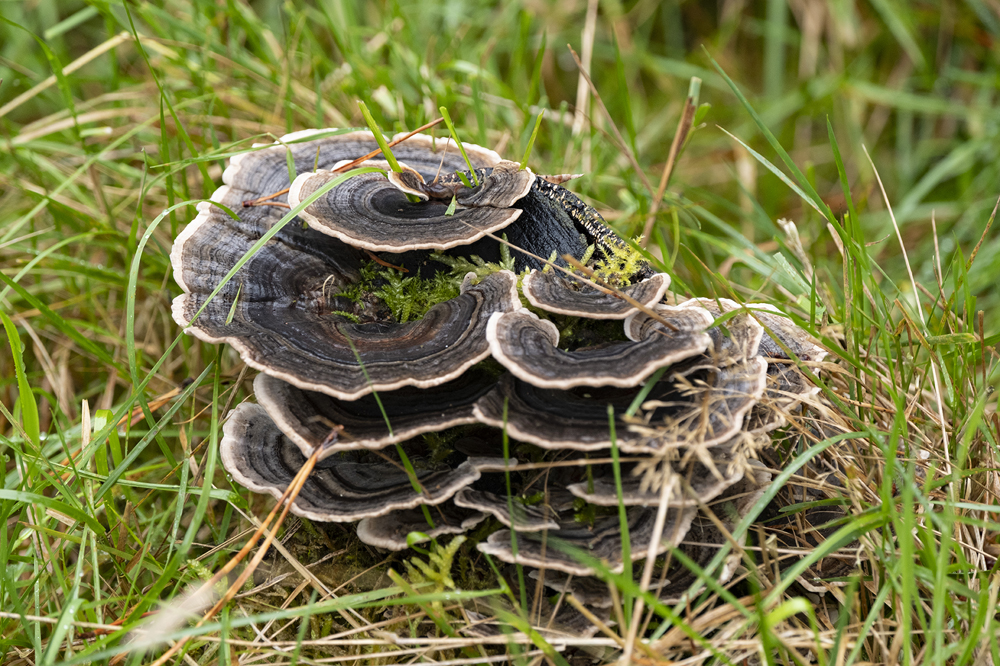
Quickly it is becoming obvious that it’s going to take more than one visit to the woods to feel comfortable taking much home for a fry up, not without Kev’s guidance or that of another bushcraft expert at least. Some fungi, even poisonous ones, have medicinal properties too, like the Turkey Tail (left) which has beneficial effects in boosting the immune system. But that’s an area of foraging for another day.
Ready for breakfast – edible treats
I’ve already mentioned a few edible ones, but are there any really tasty ones which would be a prize to take home? In these particular woods we found two which would make a good meal or an addition to one. First the Bolete family – we found Brown Birch Bolete, but there are others like Larch Bolete. As with all edible fungi, it’s advisable not to eat them raw. They are safer and more tasty cooked.



The delicious Brown Birch Bolete


The fragrant and tasty, blue-coloured Aniseed Funnel
A treat for the senses, though, is the Aniseed Funnel. This is one you find before you actually see it. It’s surprisingly hard to spot despite being bluish in colour, but the scent of aniseed is unmistakeable and it is usually that which alerts you that it’s around. Can you imagine a fry up with aniseed flavoured mushroom. Now that I have to try.
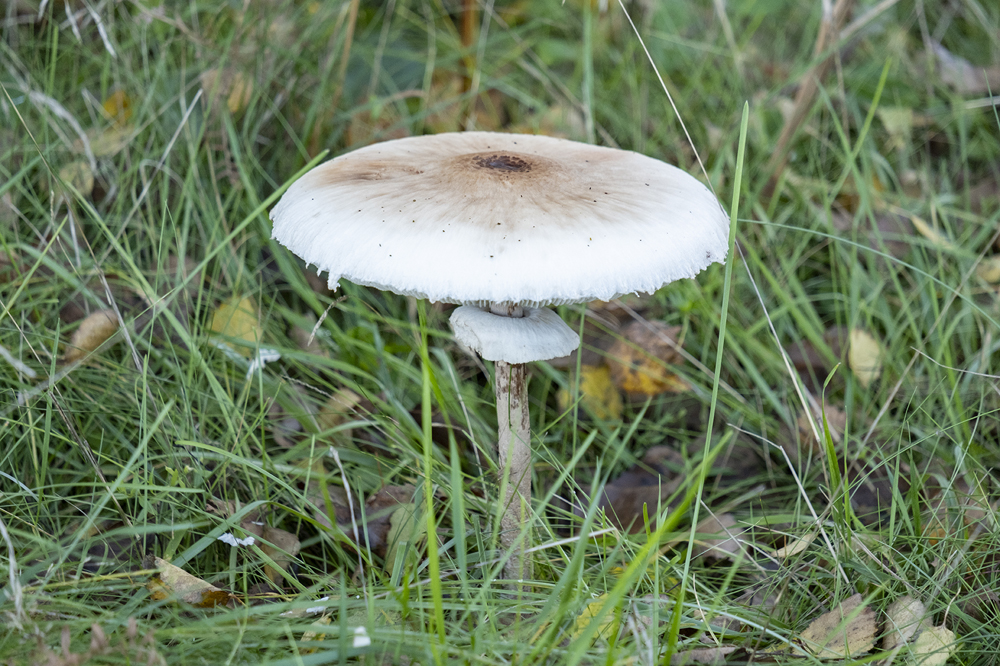
Tawny Grisette is another edible fungus, but this one needs to be put in boiling water for a few minutes, then drained before frying. The Parasol family of mushrooms (left) are a good eat too. They are more common on grassland on the edges of the woods and that’s where we found one. It was huge – 18cm (7 inches) across the cap – the size of a dinner plate.
Within any woodland there are dead and dying trees – some from old age, others from storm damage, sometimes from disease. Good markers these dead or dying are Horseshoe fungus and Birch Polypores. They stick out of tree trunks like large clam shells. They aren’t edible, in fact they’re either leathery or extremely hard, but have their uses. Part of the Horseshoe fungus, for example, can be used as tinder to start a campfire.



Tough and leathery, these fungi are found on dead or dying trees. Sometimes they actually kill the tree
All isn’t what it seems
Perhaps the most unusual and arguably prettiest fungi that we found were from the Coral family. These fungi are so delicate and although bright yellow, amongst the autumn leaf fall they’re surprisingly hard to spot. In the main woodland we found a solitary Upright Coral. Near some Scotch Pines there was also a singular Yellow Staghorn. In case you’re wondering, these aren’t edible.


Beautiful and delicate Coral fungi – Upright Coral (left) and Yellow Staghorn (right)
Along some of the path edges, especially towards the fringes of the woodland, and some more open areas we find a few more plants. There was more chickweed but also very close together there was Ground Ivy, which has an aromatic mint smell, in amongst some young Hemlock. Adjacent to this was some Cow Parsley. The leaves of Cow Parsley and Hemlock look remarkable similar but one will taste nice with fish and the other will kill you! Only about 50g of Hemlock will do the trick so be very careful. The Cow Parsley was a more vivid green colour but that may just have been the age of the plant. The way to tell them apart, other than living or dying, is – Cow Parsley is covered in fine downy hair and has a U-shaped grove running down the leaf stem. Hemlock has a round stem. Perhaps the best distinguishing feature is the smell – Cow Parsley has a fresh smell, whereas Hemlock smells acrid.

Two plants which look similar but one is delicious and the other deadly – Hemlock (left) and Cow Parsley (right)
The mature Hemlock plant has a lot of similarities with another edible plant from the ‘carrot or celery’ family – Hogweed. We found Hogweed in flower but also some with seed heads. The two different plants, Hemlock and Hogweed, were less than a metre apart. It’s the seeds of the latter which I tasted then took home with me. They have a gentle taste of cardamon and lemon. This makes them ideal to give coffee an interesting twist. On Kev’s recommendation, I tried mine in a rice pudding. I was sceptical, but I have to say it really added something to the flavour and I’d definitely do it again.



Hogweed is an edible plant with medicinal properties. before the flowers open the florette can be cooked like broccoli. The mild cardamon and lemon flavoured seeds can be used in coffee or rice pudding.
Another surprising plant is Burdock. The roots are high in carbohydrate and can be eaten, with the added medicinal benefit of being a blood purifier, getting toxins out of the blood. Combined with its diuretic properties to remove them from the body. It is used in medicinal drinks like Dandelion and Burdock too. In the autumn, it’s dying back but the seed heads have a story to tell. Brushing past the plant with these heads will inevitably lead to some being stuck to your clothing. Certain if you have a dog then you’ll be pulling some out of its fur after a walk in the woods. It was just such a scenario which inspire Swiss inventor George de Mestral. In the 1940’s while removing burdock seed he came up with the idea for something we have all no doubt used… Velcro. This invention has revolutionised contemporary living as a quick and easy fastener.


Burdock seed heads – the inspiration for Velcro
Photographing fungi
I found fungi intriguing from a photography perspective. Of course the more flamboyant ones catch the eye but I spent a lot of time lying on the ground trying to get low and interesting angles using narrow depth of field and, in some cases, backlight. I did all my shots with natural light but I know some photographers use torches or small battery lights for additional illumination. Maybe I’ll try that next. A close focus or macro lens is a must to get anything interesting from a low viewpoint. Looking at mushrooms close up fascinated me. It’s not really something I’ve paid too much attention to before but they are yet another example of nature’s beauty. Turning a mushroom over reveals the gills, and some have the most incredible architecture.
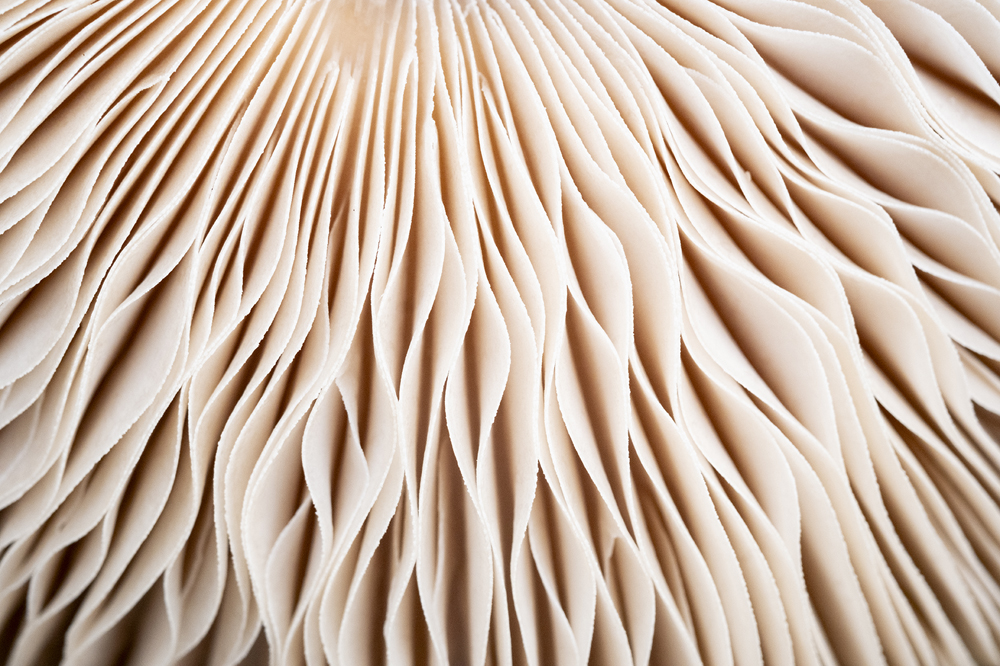
Nature by design – the beautiful gills can make striking photographs
I’m a great lover of woodland, especially broadleaf woodland, My frequent walks are enriching and uplifting. Venturing into them with a bushcraft expert takes them to a whole new level of interesting. I learnt so much and got to combine learning with my passion for photography. Of course this was only a snapshot of one woodland in one country on one particular day. I have lots more to learn, but a peep into the world of fungi was fascinating. I’m now reading up on the symbiotic relationship between them and trees, how they communicate and finding out more about this wooden world; a world that we are only recently starting to find out about and understand.
As we chatted, Kev told me more about campfire craft. He is also an expert on campfire cooking so next autumn we’re looking to put together a special workshop – foraging and photography, capped off by an evening around the campfire, cooking what we find that day. There will be limited places so if you’re interested let us know and we’ll put your name on the list for when we have more details.


Shooting from a low viewpoint adds drama and detail – A macro lens adds a different perspective to a Parasol mushroom and Lilac (Rose) Bonnet, both with cobwebs
Another woodland foray is definitely called for, so we’ve already pencilled in a walk to discover the world of plants next spring when the new foliage starts to come through. I hope to find out more about the medicinal properties of flora and fauna in the woodlands then too.
I returned to Monty absolutely buzzing from an amazing day in nature, still trying to assimilate all I’d learned from Kev’s extensive experience. Aside from being a wealth of knowledge, Kev was great company, though I’m sure he was exhausted from my non-stop stream of questions. Definitely a day to remember!
A big thank you to Kevin Palmer for his expertise in helping compile this feature. Kev is a freelance bushcraft expert. He can be contacted by email: kev@liveprimally.com
All images © Chris Coe

